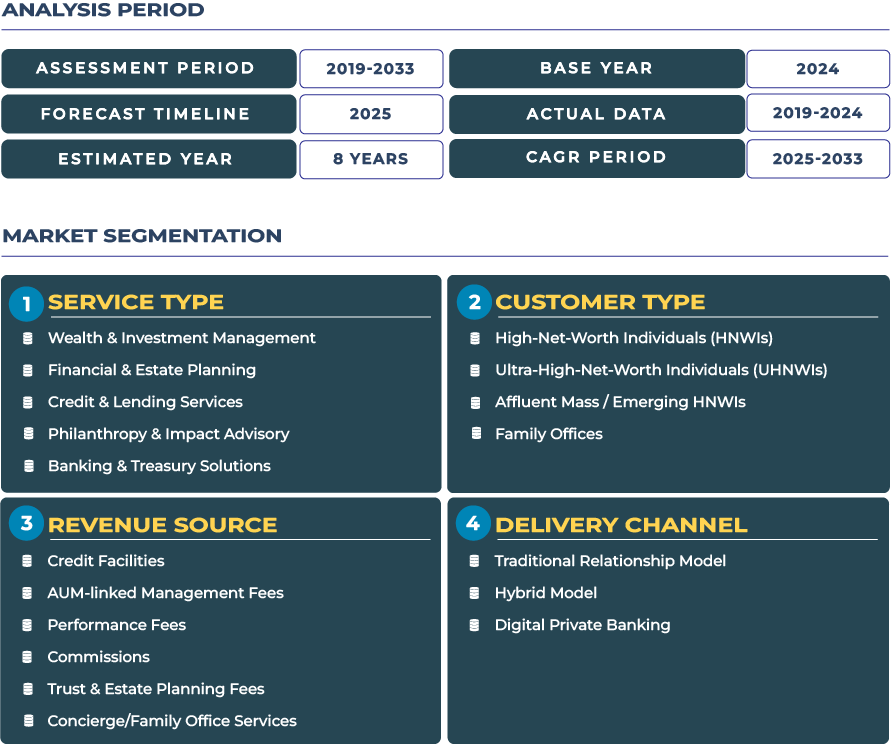Market Outlook: Strategic Horizon for France’s Private Banking Market Through 2033
The outlook for the private banking industry in France is characterised by steady growth with deep underlying transformation. With market size projected to climb from USD 42.5 billion in 2025 to USD 52.8 billion by 2033, the implied CAGR of about 2.8% reflects maturer market dynamics and the need for strategic differentiation. The affluent-client segment remains robust: France aggregates significant wealth from entrepreneurs, family offices and international executives, and this base supports demand for holistic private banking solutions.
Note:* The market size refers to the total revenue generated by banks through various services.
However, growth is not purely about scale-it is about upgrading service models. Demand is shifting toward integrated wealth platforms that link investment services with bespoke lending, payments/treasury flows, and embedded insurance. For France, this means private banks must adapt to client expectations for digital access, real-time liquidity, cross-border wealth planning and sustainable-investment vehicles. The economic backdrop-persistent inflation, sluggish GDP growth, energy-price volatility and tightening regulation-adds complexity. Firms that focus on operational efficiency, client-journey orchestration and innovative value propositions will be best positioned to capture the 2.8% CAGR horizon.
Growth Catalysts & Structural Barriers: What Fuels and What Hinders France’s Private Banking Market
Growth catalysts: Several powerful drivers support the French private banking market’s momentum. First, France boasts a sizeable affluent and ultra-high-net-worth (UHNW) population, including entrepreneurs and business-owner families seeking wealth-management services, succession planning and global advisory. Also, digital adoption among affluent French clients is accelerating, enabling private banks to embed payments, digital onboarding, treasury functionality and integrated investment advisory. ESG (environmental, social, governance) investment demand is highly visible in France-industry surveys show 72% of French individuals expect their advisor to ask about responsible investment opportunities. Finally, regulatory frameworks and France’s asset-management infrastructure provide a stable base for private banks to expand value-added services, especially around alternative investments and global wealth flows.
Structural barriers: Nevertheless, the French private banking market faces headwinds. The modest 2.8% CAGR reflects structural constraints: profitability pressure, margin compression and high cost-to-serve. Asset-management statistics show that although assets under management reached €4,970 billion by end-2023, operating profit fell 7.5% due to rising costs. Geopolitical and macro-economic factors such as energy-price shocks, inflation and uncertain global trade growth add risk. Additionally, legacy service-delivery models still dominate many French private banks-siloed advisory, deposits, lending and insurance rather than integrated ecosystems. Competitive pressure from wealth-tech entrants and cross-border banks increases urgency for transformation. In sum, French private banking growth will depend on innovation rather than volume alone.
Trend-Lines & Opportunity Frames: Emerging Dynamics in France’s Private Banking Landscape
Emerging trends: A set of distinctive trends is shaping France’s private banking sector. Digital-wealth platforms are rising rapidly: affluent clients now expect mobile-first advisory, integrated payments and real-time liquidity as part of the private-banking service. Sustainability and ESG integration are powerful forces-French advisors and banks increasingly embed impact-investing, green finance and philanthropy into wealth strategies. Cross-border wealth flows and international mobility of high-net-worth individuals require private banks to offer global advisory, tax structuring and multi-jurisdiction capabilities.
Opportunity frames: For private banking firms in France, several opportunity zones stand out. First, next-gen wealth-millennial and Gen Z inheritors-represent growth potential if banks adapt delivery models, introduce thematic investment services and digital engagement platforms. Second, regional hubs like Paris, Lyon and the Côte d’Azur remain dense with entrepreneurs and families requiring advanced private banking solutions, including alternative asset access, securities-based lending and integrated treasury. Third, embedding payments and treasury flows into the wealth-management journey-such as real-time domestic and cross-border payments, digital wallets for wealthy clients, and liquidity layering-offers deeper engagement and wallet share. Lastly, banks that can combine global coverage (for mobility and cross-border wealth) with refined local advisory will capture the competitive edge.
Competitive Landscape: Strategic Shifts Defining France’s Private Banking Sector
The French private banking market is undergoing active strategic realignment. Leading institution BNP Paribas’s private-banking arm, recognised by industry awards as best in France, has focused on digitalisation, sustainability and ultra-HNW client segmentation. Across the market, strategic moves include consolidation (e.g., France’s Group Banque Richelieu acquiring Swiss private-bank unit Kaleido in 2025) and digital-wealth initiatives addressing next-gen affluent. Competitive strategies revolve around three core pillars: segmentation by client cohort (ultra-HNW vs next-gen affluent), platform integration across investment, payments, credit, treasury, and insurance, and partnerships with fintechs, alternative-asset platforms, and global wealth-advisory hubs. In this competitive race, French private banks that shift from product distribution to ecosystem orchestration will define leadership.







